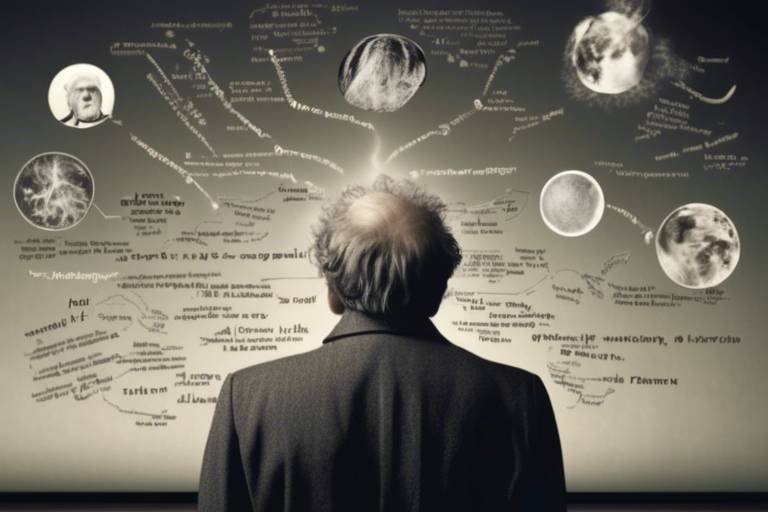The Philosophy of Conceptual Design in Technology
In today's fast-paced technological landscape, the concept of conceptual design has emerged as a crucial pillar that supports the transformation of abstract ideas into innovative solutions. But what exactly is conceptual design? At its core, it is the process of developing a clear and coherent vision that guides the creation of products, systems, or services. This philosophy is not merely about aesthetics; it encompasses a broader understanding of user needs, market demands, and technological capabilities.
Imagine you're an architect tasked with designing a new building. Before laying the first brick, you need a blueprint that outlines not just the structure but also how it fits into the surrounding environment. Similarly, in technology, conceptual design acts as that blueprint, helping teams visualize the end product and anticipate challenges before they arise. It is this forward-thinking approach that enables companies to innovate and stay relevant in a competitive market.
The importance of conceptual design cannot be overstated. It serves as a bridge between creativity and practicality, allowing designers and engineers to explore new ideas while maintaining a focus on feasibility. By establishing a solid conceptual framework, teams can streamline their development processes, reduce costs, and enhance collaboration among stakeholders. This ensures that everyone involved shares a common understanding of the project's goals and objectives.
Furthermore, conceptual design is not static; it evolves with technological advancements and changing user expectations. As we delve deeper into this article, we will explore how historical contexts, influential theories, and emerging methodologies shape the philosophy of conceptual design. By understanding these elements, we can better appreciate the profound impact that conceptual design has on innovation and user experience in technology.
To illustrate the significance of conceptual design in technology, consider the following table, which outlines the key benefits of implementing a robust conceptual design phase in product development:
| Benefit | Description |
|---|---|
| Enhanced Creativity | Encourages out-of-the-box thinking, leading to innovative solutions. |
| Improved Collaboration | Aligns team members on project goals, fostering teamwork. |
| Risk Mitigation | Identifies potential issues early in the process, reducing costly revisions. |
| User Focus | Prioritizes user needs and preferences, enhancing overall satisfaction. |
In summary, the philosophy of conceptual design in technology is about creating a solid foundation for innovation. It encourages a thoughtful approach that integrates creativity, practicality, and user-centricity, ultimately leading to products that resonate with users and stand the test of time. As we continue to explore this fascinating topic, we will uncover the historical context, influential theories, and methodologies that enrich the conceptual design landscape.

Understanding Conceptual Design
Conceptual design is more than just a buzzword in the tech world; it's the blueprint for transforming abstract ideas into functional solutions. Imagine trying to build a house without a plan—chaos, right? Well, that’s what it’s like to dive into technology development without a solid conceptual design. At its core, conceptual design involves visualizing an idea and laying the groundwork for its realization, ensuring that every step of the development process is aligned with the primary vision.
So, why is conceptual design so crucial? For starters, it acts as a bridge between creativity and practicality. By focusing on the *why* and *how* of a project, designers can better understand user needs and market demands. This understanding leads to solutions that are not only innovative but also user-friendly. The importance of conceptual design can be summarized in a few key points:
- Clarity: It provides a clear direction for the development team.
- Alignment: Ensures that all stakeholders are on the same page.
- Efficiency: Saves time and resources by minimizing revisions later in the process.
- Innovation: Encourages creative thinking and exploration of new ideas.
In essence, conceptual design shapes the entire development process. It’s the stage where ideas are fleshed out, where brainstorming meets structure. This is where designers can sketch out their visions, create flowcharts, and even develop initial mock-ups. All of these tools help in visualizing how the final product will function and interact with users.
Moreover, conceptual design is not a one-size-fits-all approach. Different projects may require different methodologies, whether it’s a rapid prototyping technique or a more traditional design process. What’s important is that the chosen method aligns with the project's goals and the needs of its intended audience. This adaptability is what makes conceptual design a powerful tool in technology development.
To illustrate the significance of conceptual design in technology, let’s consider a simple analogy. Think of it as a roadmap for a long journey. Without a roadmap, you might end up lost, wasting time and energy. However, with a well-defined path, you can navigate challenges more effectively and reach your destination smoothly. Similarly, conceptual design provides the necessary guidance to navigate the often complex landscape of technology development.
In conclusion, understanding conceptual design is essential for anyone involved in technology. It lays the groundwork for innovation, ensuring that ideas are not only creative but also viable and user-centered. As we delve deeper into the historical context and methodologies of conceptual design in the following sections, we will uncover how this foundational principle continues to shape the future of technology.

Historical Context of Conceptual Design
The journey of conceptual design is as fascinating as the technology it seeks to enhance. It’s like tracing the roots of a mighty tree, where each branch represents a significant milestone in the evolution of design principles. Conceptual design has transformed dramatically over the decades, reflecting the rapid advancements in technology and human understanding. In the early days, design was primarily about functionality and aesthetics. However, as technology progressed, the need for a more structured approach emerged, leading to the development of various design philosophies.
In the mid-20th century, the rise of modernism brought about a significant shift in design thinking. Influential figures such as Charles and Ray Eames emphasized the importance of user experience, paving the way for a more human-centered approach. Their work highlighted how design could enhance everyday life, not just in terms of utility but also in emotional resonance. This era marked the beginning of understanding that design is not merely about creating objects; it’s about creating experiences.
As we moved into the late 20th century, the advent of computers and digital technology revolutionized conceptual design. The introduction of software tools allowed designers to visualize their ideas in ways that were previously unimaginable. This period also saw the emergence of interaction design, focusing on how users engage with technology. Designers began to recognize that the way a product functions and interacts with its users is just as important as its physical appearance.
To illustrate this evolution, let’s take a look at some key milestones in the history of conceptual design:
| Year | Milestone | Influence |
|---|---|---|
| 1960s | Rise of Modernism | Focus on functionality and user experience |
| 1980s | Digital Revolution | Introduction of computer-aided design (CAD) |
| 1990s | Interaction Design Emergence | Shift towards user engagement and experience |
| 2000s | Design Thinking Popularization | Human-centered approaches become mainstream |
Today, conceptual design is not just about creating products; it’s about crafting experiences that resonate with users on multiple levels. The integration of cognitive science and psychology into design processes has further enriched this field, allowing designers to create solutions that are not only innovative but also intuitively aligned with users' needs. As we look to the future, the historical context of conceptual design reminds us that every breakthrough is built on the shoulders of those who came before us.
In conclusion, understanding the historical context of conceptual design is crucial for anyone involved in technology and design. It provides insights into how far we’ve come and the principles that continue to guide us. As we move forward, it’s essential to keep this rich history in mind, ensuring that we honor the past while innovating for the future.
- What is conceptual design? - Conceptual design is the process of translating ideas into tangible solutions, focusing on user experience and functionality.
- How has technology influenced conceptual design? - Technology has transformed conceptual design by introducing new tools and methodologies that enhance creativity and user engagement.
- Why is user experience important in conceptual design? - User experience is crucial as it directly impacts how users interact with and perceive a product, influencing satisfaction and usability.
- What are some methodologies used in conceptual design? - Common methodologies include design thinking, systems thinking, and user-centered design approaches.

Influential Theories
When we dive into the realm of conceptual design, we quickly realize that it doesn’t exist in a vacuum. Rather, it is deeply intertwined with various influential theories that have shaped its trajectory. One of the most significant is philosophical theory, which encourages designers to consider the broader implications of their work. Think about it: every design decision we make can influence how users interact with technology, how they perceive it, and even how it shapes their lives. This philosophical lens prompts us to ask, “What impact does this design have on society?”
Another cornerstone of conceptual design is rooted in cognitive science. This discipline provides insights into how people think, learn, and remember, which is crucial for creating effective designs. For instance, understanding cognitive load can guide designers in presenting information in a way that is digestible and intuitive. If a design overwhelms users with too much information at once, it can lead to frustration and disengagement. Instead, by applying cognitive principles, designers can create a more harmonious interaction between users and technology.
Among the notable theories, Gestalt principles stand out. These principles explain how we perceive visual elements as a unified whole rather than as individual parts. For example, when designing an app interface, employing Gestalt principles can help in organizing elements so that users intuitively understand the relationships between them. By leveraging concepts like proximity, similarity, and closure, designers can create interfaces that feel cohesive and user-friendly.
To further illustrate the impact of these theories, consider the following table that summarizes key theories and their implications for conceptual design:
| Theory | Key Focus | Implications for Design |
|---|---|---|
| Philosophical Theory | Broader societal impact | Encourages ethical considerations in design |
| Cognitive Science | Human thought processes | Informs usability and information presentation |
| Gestalt Principles | Visual perception | Enhances user interaction through intuitive design |
Moreover, the integration of these theories into practical design processes leads to a more enriched user experience. For instance, when designers embrace the principles of human-centered design, they prioritize the needs and experiences of users above all else. This approach not only aligns with cognitive and philosophical theories but also fosters a deeper connection between the user and the product.
In conclusion, understanding these influential theories allows designers to create more meaningful and effective conceptual designs. By considering the philosophical implications, cognitive processes, and perceptual principles, designers can craft solutions that resonate with users and stand the test of time. The interplay of these theories serves as a guiding light, illuminating the path toward innovative and user-friendly technology.
- What is conceptual design? Conceptual design is the process of translating ideas into tangible solutions, often focusing on user experience and innovation.
- How do influential theories impact design? Theories from philosophy, cognitive science, and visual perception guide designers in creating user-centered and effective solutions.
- What is the role of user-centered design? User-centered design prioritizes the needs and preferences of users, ensuring that products are intuitive and meet user expectations.
- Why is prototyping important? Prototyping allows designers to test and refine their ideas, ensuring that the final product aligns with user needs and expectations.

Design Thinking
is more than just a buzzword; it's a powerful methodology that has transformed the way we approach problems in technology and beyond. At its core, design thinking is all about empathy and creativity. It encourages designers to step into the shoes of the users, understanding their needs, frustrations, and desires. This human-centered approach not only fosters innovative solutions but also ensures that the end product resonates with the target audience.
The design thinking process typically unfolds in several stages, often illustrated as a cycle that can be revisited as needed. These stages include:
- Empathize: Understand the users and their needs through observation and engagement.
- Define: Clearly articulate the problem you aim to solve based on insights gathered.
- Ideate: Brainstorm a wide range of ideas and solutions without judgment.
- Prototype: Create tangible representations for a subset of ideas to explore their viability.
- Test: Gather feedback from users to refine and improve the solutions.
This iterative process allows for continual learning and adaptation, making it a dynamic approach to problem-solving. Think of it as a dance where each step informs the next, leading to a more harmonious outcome. Instead of rigidly sticking to a plan, design thinking embraces flexibility, allowing teams to pivot based on user feedback and real-world challenges.
One of the most exciting aspects of design thinking is its collaborative nature. It brings together individuals from diverse backgrounds and disciplines, fostering a rich environment for creativity. When engineers, designers, marketers, and end-users collaborate, the results can be astounding. This cross-pollination of ideas often leads to unexpected solutions that might not have emerged in a more siloed approach.
Moreover, design thinking is not just limited to product development; it can be applied to various fields, including education, healthcare, and business strategy. For instance, in healthcare, design thinking might be used to improve patient experiences by understanding their journeys and identifying pain points. By focusing on the human experience, organizations can create solutions that are not only effective but also deeply meaningful.
In conclusion, design thinking is a revolutionary approach that emphasizes empathy and creativity in problem-solving. Its iterative nature and collaborative spirit make it a valuable tool for anyone looking to innovate in the technological landscape. By putting the user at the heart of the process, we can create solutions that truly resonate and make a positive impact on their lives.

Systems Thinking
When we talk about , we're diving into a mindset that encourages us to view problems not just as isolated incidents, but as part of a larger, interconnected web. Imagine you're trying to fix a car. If you only focus on the engine without considering how it interacts with the transmission or the electrical system, you might miss the bigger picture. Similarly, in conceptual design, systems thinking allows designers to see how various components of a project influence one another, leading to more holistic solutions.
This approach is particularly crucial in the realm of technology, where products and systems are often complex and multi-faceted. By applying systems thinking, designers can identify relationships and dependencies that might not be immediately obvious. This is akin to being a detective, piecing together clues from different sources to solve a mystery. It helps in understanding how changes in one area can ripple through the entire design, affecting user experience and functionality.
One of the key principles of systems thinking is the idea of feedback loops. These loops can be either positive or negative, and they help in understanding how different elements within a system influence each other over time. For instance, consider a software application that collects user data. If the application improves its features based on user feedback, it creates a positive feedback loop that enhances user satisfaction and engagement. On the other hand, if the application fails to address user concerns, it can lead to a negative feedback loop, resulting in decreased usage and negative reviews.
Moreover, systems thinking promotes the concept of interdisciplinary collaboration. In the design process, bringing together experts from various fields—such as engineering, psychology, and marketing—can lead to richer insights and more innovative solutions. This collaborative approach can be visualized in a simple table:
| Field | Contribution |
|---|---|
| Engineering | Technical feasibility and functionality |
| Psychology | User behavior and experience insights |
| Marketing | Understanding market needs and trends |
Incorporating systems thinking into the conceptual design process also helps in identifying potential risks and challenges before they become significant issues. By looking at the system as a whole, designers can anticipate how different elements might interact and what unintended consequences might arise. This proactive approach is essential for creating robust and resilient designs that can adapt to changing conditions.
In summary, systems thinking is a powerful tool in the conceptual design toolkit. It encourages a comprehensive view of design challenges, fosters collaboration among diverse disciplines, and helps anticipate the complex interactions within systems. As technology continues to evolve, embracing this mindset will be crucial for creating innovative solutions that truly meet the needs of users.
- What is systems thinking? Systems thinking is an approach that views problems as part of a larger system, emphasizing the interconnections and relationships between different components.
- How does systems thinking apply to design? In design, systems thinking helps identify how various elements influence each other, leading to more holistic and effective solutions.
- Why is interdisciplinary collaboration important in systems thinking? Collaboration among different fields brings diverse perspectives and expertise, enhancing the design process and fostering innovation.
- What are feedback loops? Feedback loops are cycles of cause and effect within a system, where changes in one area can influence others, either positively or negatively.

Methodologies in Conceptual Design
When diving into the world of conceptual design, one quickly realizes that it’s not just about coming up with a brilliant idea; it’s about how to systematically bring that idea to life. There are various methodologies that guide designers through this intricate process, each with its own unique strengths and applications. Understanding these methodologies is crucial for anyone involved in technology development, as they provide a structured framework that can lead to innovative solutions.
One of the most prominent methodologies is the **Waterfall Model**, which is linear and sequential. Think of it as a well-organized assembly line where each phase must be completed before the next one begins. This model is particularly effective for projects with clear requirements and scope. However, its rigidity can be a double-edged sword, as it may not adapt well to changes once the project is underway.
On the other hand, we have the **Agile Methodology**, which embraces flexibility and iterative progress. Imagine a sculptor chipping away at a block of marble, gradually revealing the masterpiece within. Agile allows for continuous improvement and adaptation based on user feedback. This approach is especially beneficial in technology, where user needs can evolve rapidly. Teams work in short cycles, known as sprints, which encourages collaboration and quick responses to challenges.
Another noteworthy methodology is **Design Thinking**, which centers around empathy and user experience. It encourages designers to step into the users' shoes, understanding their needs and pain points. This methodology comprises five stages: Empathize, Define, Ideate, Prototype, and Test. By following these stages, designers can create solutions that truly resonate with users. It’s like crafting a tailored suit; you wouldn’t just guess the measurements—you’d take the time to understand the unique fit required.
In addition to these methodologies, there’s also **Systems Thinking**, which promotes a holistic view of design problems. This approach encourages designers to consider the broader context in which their solutions will exist. By understanding how various components interact within a system, designers can create more effective and sustainable solutions. It’s akin to being a conductor of an orchestra; you need to understand how each instrument contributes to the harmony of the whole piece.
For those looking to implement these methodologies effectively, it’s essential to choose the right one based on the project’s specific needs and context. Here’s a quick comparison of the methodologies:
| Methodology | Key Characteristics | Best Suited For |
|---|---|---|
| Waterfall | Linear, sequential, rigid | Projects with clear requirements |
| Agile | Iterative, flexible, collaborative | Projects requiring adaptability |
| Design Thinking | User-centered, empathetic, iterative | Creating solutions based on user needs |
| Systems Thinking | Holistic, interconnected, contextual | Complex problems needing a broader perspective |
Ultimately, the choice of methodology can significantly influence the success of a project. By understanding the strengths and applications of each approach, designers can better navigate the challenges of conceptual design. It’s not just about having a great idea; it’s about having the right strategy to turn that idea into reality. So, which methodology resonates with you? Are you ready to dive into the world of conceptual design with a fresh perspective?
- What is conceptual design?
Conceptual design is the initial phase of the design process where ideas are generated and translated into tangible concepts.
- Why is user experience important in conceptual design?
User experience is crucial because it ensures that the final product meets the needs and expectations of its users, leading to greater satisfaction and usability.
- What are the benefits of using Agile methodology?
Agile methodology allows for flexibility, quick adaptation to changes, and continuous feedback, making it ideal for projects where user needs may evolve.
- How does Design Thinking differ from traditional design methods?
Design Thinking emphasizes empathy and user-centric approaches, focusing on understanding user needs before developing solutions.

The Role of User Experience
User Experience (UX) is not just a buzzword; it’s the beating heart of conceptual design. Imagine walking into a store where everything is perfectly arranged, the lighting is just right, and the staff is friendly and helpful. This feeling of comfort and satisfaction is what UX aims to replicate in the digital world. It’s all about creating products that not only function well but also resonate with users on an emotional level. The significance of UX in conceptual design cannot be overstated, as it directly influences how users interact with technology and ultimately determines the success of a product.
At its core, UX is about understanding the user’s journey. This journey includes every interaction a user has with a product, from the first moment they hear about it to the time they decide to use it. In this context, conceptual design serves as the blueprint for that journey. It’s essential to ask ourselves: What do users want? What problems are they trying to solve? By answering these questions, designers can create solutions that not only meet user needs but also delight them.
Moreover, the role of UX in conceptual design can be broken down into several key components:
- Empathy: Understanding the user's feelings and experiences is crucial. Designers must put themselves in the users' shoes to create solutions that truly resonate.
- Usability: A product must be easy to use. If users find a design confusing or cumbersome, they are likely to abandon it for something more intuitive.
- Accessibility: Ensuring that all users, regardless of their abilities, can access and benefit from a product is a fundamental principle of good UX.
To illustrate the impact of UX on conceptual design, let’s consider a simple table that outlines the differences between a product with strong UX and one with weak UX:
| Aspect | Strong UX | Weak UX |
|---|---|---|
| Navigation | Intuitive and seamless | Confusing and frustrating |
| Feedback | Immediate and clear | Delayed or nonexistent |
| Emotional Response | Positive and engaging | Negative and disengaging |
This table clearly demonstrates how strong UX can enhance user satisfaction and engagement, while weak UX can lead to dissatisfaction and abandonment. The implications for designers are profound: investing in UX is not merely an option; it’s a necessity for successful conceptual design.
In conclusion, the role of user experience in conceptual design is paramount. It shapes not only how users interact with a product but also how they perceive it. A well-thought-out UX strategy can be the difference between a product that thrives and one that fades into obscurity. By prioritizing the needs and experiences of users, designers can create innovative solutions that not only meet functional requirements but also foster a deep emotional connection with users.
- What is the primary goal of user experience design? The primary goal is to create products that provide meaningful and relevant experiences to users, ensuring their needs are met effectively.
- How does UX impact product success? A positive UX leads to higher user satisfaction, increased engagement, and ultimately, better sales and loyalty.
- What are some common methods used to enhance UX? Methods include user research, usability testing, prototyping, and iterative design processes.

User-Centered Design
User-centered design (UCD) is more than just a buzzword in the tech world; it’s a philosophy that places the user at the heart of the design process. Imagine crafting a tool that feels like it was made just for you—this is the essence of UCD. By focusing on the needs, preferences, and limitations of end-users, designers can create solutions that are not only functional but also intuitive and enjoyable to use. This approach is crucial in today’s fast-paced digital landscape, where user satisfaction can make or break a product.
At its core, UCD involves a deep understanding of the user’s environment and behavior. It’s about asking the right questions: What do users want? What challenges do they face? How can we make their lives easier? By engaging with users throughout the design process, teams can gather invaluable insights that inform every decision, from initial sketches to final prototypes.
One of the primary methods of implementing UCD is through iterative design, which allows for continuous feedback and improvement. This means that instead of developing a product in isolation, designers create prototypes and test them with real users. The feedback collected during these testing phases is then used to refine the product further. This cycle of designing, testing, and refining ensures that the final product aligns closely with user expectations.
In practice, user-centered design can be broken down into several key principles:
- Empathy: Understanding users' emotions and experiences is crucial. This can be achieved through interviews, surveys, and observational studies.
- Involvement: Users should be involved throughout the design process, providing feedback at various stages.
- Accessibility: Designs should be inclusive, ensuring that all users, regardless of their abilities, can interact with the product.
- Usability: The product should be easy to use, with a clear and intuitive interface that minimizes the learning curve.
Moreover, the impact of UCD extends beyond just user satisfaction. By prioritizing user needs, companies can also enhance their brand loyalty and reduce costs associated with customer support. When users find a product easy to use, they are less likely to encounter problems that require assistance. This not only saves time and resources but also fosters a positive relationship between the user and the brand.
As technology continues to evolve, the importance of user-centered design will only grow. With the rise of artificial intelligence and machine learning, UCD will play a critical role in ensuring these technologies are accessible and beneficial to all users. The challenge for designers will be to maintain a human touch in increasingly automated environments, ensuring that technology serves to enhance the user experience rather than complicate it.
In summary, user-centered design is a vital approach in creating effective and engaging products. By focusing on the user at every stage of the design process, companies can develop solutions that not only meet but exceed user expectations, leading to greater satisfaction and success in the marketplace.
- What is user-centered design? User-centered design is a design philosophy that prioritizes the needs and experiences of users throughout the design process.
- Why is user-centered design important? It ensures that products are tailored to user needs, leading to higher satisfaction, better usability, and reduced support costs.
- How can I implement user-centered design in my projects? Involve users in the design process through interviews, testing prototypes, and gathering feedback to refine your designs.
- What are some common methods used in user-centered design? Common methods include usability testing, user interviews, and creating user personas to guide design decisions.

Prototyping and Testing
Prototyping and testing are crucial steps in the conceptual design process, acting as the bridge between abstract ideas and real-world applications. Imagine you're building a bridge; before you construct it, you’d want to test its design with models to ensure it can withstand the weight of traffic. Similarly, in technology, prototypes allow designers to explore ideas and validate them before full-scale production. This iterative process not only enhances creativity but also minimizes risks associated with launching a new product.
Prototyping can take many forms, from low-fidelity sketches and wireframes to high-fidelity interactive models. Each type serves a different purpose and audience. For instance, low-fidelity prototypes, such as paper sketches, are excellent for early brainstorming sessions, allowing teams to quickly iterate on ideas without getting bogged down in details. Conversely, high-fidelity prototypes provide a more realistic representation of the final product, which is essential for user testing and feedback.
Testing, on the other hand, is where the magic happens. It’s not just about seeing if a design works; it’s about understanding how users interact with it. This phase often involves observing users as they engage with the prototype, gathering insights on their behaviors, preferences, and pain points. By employing techniques such as usability testing or A/B testing, designers can identify what resonates with users and what doesn’t. This feedback loop is vital, as it informs necessary adjustments before the final product launch.
Moreover, the significance of prototyping and testing extends beyond mere functionality. They also play a pivotal role in fostering innovation. By creating an environment where experimentation is encouraged, teams can explore unconventional ideas that might not have surfaced in traditional design processes. This culture of innovation can lead to breakthrough solutions that enhance user experience and drive technological advancement.
In summary, prototyping and testing are not just steps in the design process; they are essential practices that empower designers to create effective, user-centered technologies. By embracing these methodologies, teams can ensure that their concepts not only meet user needs but also stand out in a competitive landscape.
- What is the difference between prototyping and testing?
Prototyping involves creating models of a product to explore ideas, while testing focuses on evaluating those models to gather user feedback and insights. - Why is user feedback important in the design process?
User feedback helps identify strengths and weaknesses in a design, ensuring that the final product aligns with user needs and expectations. - What are some common methods of prototyping?
Common methods include paper sketches, digital wireframes, and interactive prototypes, each serving different stages of the design process. - How often should prototyping and testing be done?
These processes should be iterative and ongoing throughout the design lifecycle, allowing for continuous improvement and adaptation.

Future Trends in Conceptual Design
As we look ahead into the horizon of technological advancements, it's evident that conceptual design is on the brink of a transformative evolution. The future of conceptual design is not just about aesthetics or functionality; it's about creating experiences that resonate with users on a deeper level. With the rapid pace of innovation, several trends are emerging that will shape the way we approach design in technology.
One of the most significant trends is the integration of artificial intelligence (AI) into the design process. AI tools are becoming increasingly sophisticated, allowing designers to analyze user data more effectively and generate insights that inform design decisions. Imagine having an AI assistant that not only suggests design elements but also predicts user preferences based on historical data. This symbiosis of human creativity and machine intelligence is set to revolutionize how we conceptualize and implement design projects.
Moreover, the rise of augmented reality (AR) and virtual reality (VR) technologies is redefining user interaction with designs. These immersive technologies enable users to engage with products and environments in ways that were previously unimaginable. For instance, a furniture company can allow customers to visualize how a piece of furniture would look in their home through AR, enhancing the decision-making process. This shift towards immersive experiences is not just a trend; it's a fundamental change in how we perceive and interact with designs.
Another noteworthy trend is the emphasis on sustainability in design practices. As awareness of environmental issues grows, designers are increasingly tasked with creating solutions that minimize ecological impact. This encompasses not only the materials used but also the entire lifecycle of a product. Future conceptual designs will likely prioritize eco-friendly materials, energy-efficient processes, and designs that promote recycling and reuse. The challenge will be to balance sustainability with the need for innovation and functionality.
Additionally, the concept of collaborative design is gaining traction. With the rise of remote work and global teams, designers are finding new ways to collaborate across borders. Tools that facilitate real-time collaboration are becoming essential, allowing designers to work together seamlessly, regardless of their physical locations. This trend not only enhances creativity but also leads to more diverse perspectives, enriching the design process.
The shift towards personalization is also a critical trend in conceptual design. Users increasingly expect products and services tailored to their unique needs and preferences. Future design processes will likely incorporate advanced data analytics to create highly personalized experiences. For example, imagine a health app that adapts its interface and suggestions based on individual user behavior and health data. This level of personalization can significantly enhance user satisfaction and engagement.
In summary, the future of conceptual design is bright and filled with possibilities. As we embrace these trends—AI integration, immersive technologies, sustainability, collaborative design, and personalization—we are not just creating products; we are crafting experiences that resonate with users and address their evolving needs. The challenge lies in adapting to these changes while maintaining a focus on the core principles of design that prioritize user experience and innovation.
- What is conceptual design? Conceptual design is the process of translating ideas into tangible solutions, focusing on the overall concept rather than the details.
- How does AI influence conceptual design? AI helps analyze user data, generate insights, and predict preferences, enhancing the design decision-making process.
- Why is sustainability important in design? Sustainability reduces ecological impact and promotes responsible use of resources, aligning design practices with environmental consciousness.
- What role does user experience play in conceptual design? User experience is pivotal as it influences design decisions and ensures that the final product meets user needs and expectations.
Frequently Asked Questions
- What is conceptual design in technology?
Conceptual design is the process of turning abstract ideas into tangible solutions. It serves as the blueprint for developing products, systems, or services, ensuring that the final outcome aligns with user needs and technological capabilities.
- Why is user experience important in conceptual design?
User experience (UX) is crucial because it shapes how users interact with a product. A focus on UX ensures that the design is intuitive, accessible, and enjoyable, ultimately leading to higher user satisfaction and better adoption rates.
- What methodologies are commonly used in conceptual design?
Several methodologies guide the conceptual design process, including Design Thinking and Systems Thinking. Design Thinking emphasizes empathy and creativity, while Systems Thinking encourages a holistic view of design challenges, allowing for comprehensive solutions.
- How does prototyping fit into the conceptual design process?
Prototyping is an essential step in conceptual design, as it allows designers to create preliminary models of their ideas. This process helps in testing concepts, gathering user feedback, and refining designs to better meet user expectations.
- What are some future trends in conceptual design?
Future trends in conceptual design include increased integration of artificial intelligence, a greater emphasis on sustainability, and the use of virtual and augmented reality for immersive user experiences. These trends are shaping the way designers approach challenges in technology.
- Who are some influential figures in the history of conceptual design?
Influential figures in conceptual design include designers and theorists like Herbert Simon, who contributed significantly to design thinking, and Donald Norman, known for his work on user-centered design. Their ideas have greatly influenced modern design practices.



















